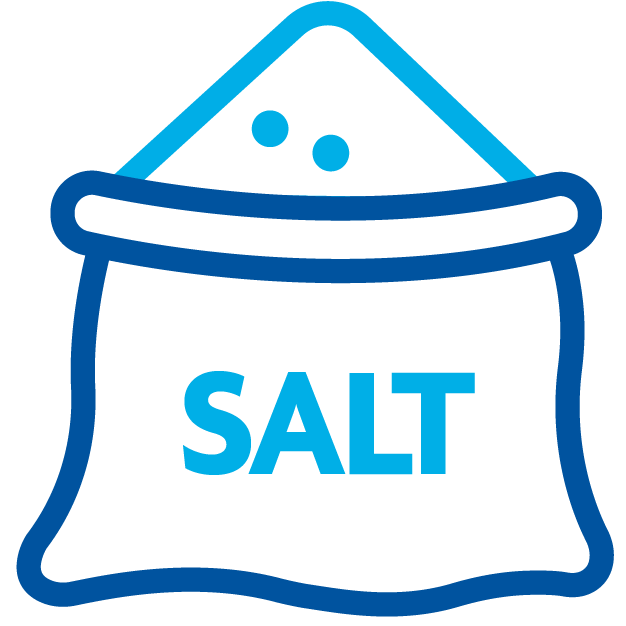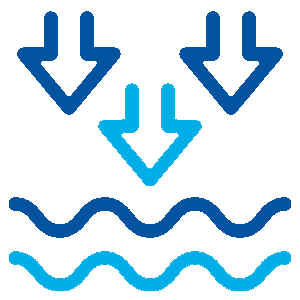
How to Balance Salt Levels in a Pool
Over the past few decades, saltwater pools have gained a reputation as being excellent alternatives to traditional, non-saltwater pools. Saltwater pools offer softer, silkier water, produce fewer chloramines, and require fewer chemicals than traditional pools. But they're not completely self-sufficient. Salt is the life source for saltwater pools, and properly balancing the salt levels in your water is crucial to maintaining a clean and healthy pool. If the levels are low, keep reading to find out how much salt to add to your pool.
Saltwater vs. Non-Saltwater Pools

The main difference between saltwater and non-saltwater pools, besides the obvious salt situation, is how they are chlorinated. Chlorine needs to be manually added to non-saltwater, or freshwater pools, as they can't generate their own supply. This can be done with chlorine tablets, liquid chlorine, or granular chlorine.
Saltwater pools, on the other hand, produce their own steady supply of chlorine with the help of a saltwater chlorine generator. They rarely require additional doses of chlorine sanitizer, aside from the occasional round of shock. But in order for a saltwater system to work properly, the salt levels in your pool need to be within the manufacturer's recommended range.
How to Manage Salt Levels in Your Pool
Without salt, the most important piece of the puzzle, your salt system can't supply the right amount of chlorine to sanitize your pool. Therefore, balancing your pool's salt content is vital to keeping your pool clean and your salt system running smoothly. Let's discuss how to manage the salt level in your pool, whether you need to increase or decrease it.
Ideal Saltwater Pool Chemistry Ranges
Before you adjust your saltwater pool's salt content, test and balance your pool water chemistry within the following ideal ranges:
- Total Alkalinity: 80–120 ppm
- pH: 7.4–7.6
- Calcium Hardness: 200–400 ppm
- Cyanuric Acid: 30–100 ppm
- Total Dissolved Solids: No more than 1,500 ppm above your salt content
PRO TIP: Cyanuric Acid, abbreviated as CYA, is especially important for saltwater pools. It works to protect the chlorine in your pool against the sun's harsh UV rays. If there's not enough CYA in your pool, the generated chlorine will break down and dissipate just as quickly as your salt system can create it, and your pool won't stay sanitized. Using a stabilized chlorine shock can help add some CYA to the pool, or you can use pool conditioner on demand as needed. Learn more in our other article, How to Balance Cyanuric Acid in a Pool.
Increasing the Salt Level in Your Pool

One major benefit of salt is that it doesn't easily disappear, nor does it get used up over time, no matter how long it sits in your pool water. This means unless your pool loses water due to a leak, backwashing the filter, excess splash-out, or some other reason, you will rarely need to add more salt to your pool. But how much salt should you add to the pool?
If you need to increase your pool's salt level for whatever reason, doing so is no different than increasing the amount of any other aspect of water chemistry. Test the water and check the salt system's control panel to determine how low the salt level currently is. Then, referencing the equation below, calculate how many pounds of additional pool salt is needed to reach the required amount.
Pool Salt Calculator
- First, find your pool's volume in gallons.
- Next, refer to your salt system's manufacturer recommendations to figure out how much salt is needed for your system. For instance, the Hayward AquaRite system requires 2,500–3,500 ppm (parts per million) of salt.
- Then — here comes the fun math part — use the following calculation to determine how many pounds of salt your pool needs:
8.375 x Salinity Increase ppm ÷ 100 = Pounds of salt per 10,000 gallons.
For example, let's say you have a 20,000-gallon pool, and you need to increase your salt level by approximately 250 ppm to get it back into the correct range:
8.375 x 250 ppm ÷ 100 = ~21 lbs of salt per 10,000 gallons
For your 20,000-gallon pool, a single 40-pound bag of pool salt would get you close to your desired range.
Decreasing the Salt Level in Your Pool

The good news is that salt levels don't just increase on their own. If salt levels are too high, it's most likely due to adding too much salt while you were trying to increase the levels. This is why it's important to go slow, and test often as you go to make sure your math was correct. A slight deviation in pool volume can have a major impact on the perceived salt dosage requirement. Keep in mind that salt takes time to dissolve in the water, so allow plenty of time for the levels to finish rising before adding more salt. If you test immediately after adding the salt, your reading will be significantly lower than the reading you'll get 24 hours later.
Unfortunately, lowering the salt level in your pool is not as simple as increasing it. Just like with elevated Calcium Hardness, Total Dissolved Solids, and Cyanuric Acid levels, the only way to decrease the salt content is by partially draining your pool. Drain and refill your pool one foot at a time, and test the salt content each time after you refill with fresh water. Once the salt level is within the recommended range, test and balance the rest of your water chemistry. For more information on how to drain your pool, check out our Pool Draining 101 blog post, or contact a Leslie's pool care expert to ask about our draining services.
DID YOU KNOW? As the chlorine in your saltwater pool works to fight off algae and bacteria, it becomes inactive, reverts back to salt, and goes through electrolysis to become chlorine again. This continuous cycle leaves you with a nearly endless supply of chlorine and salt — as long as the salt stays in your pool.
There's no need to be salty about maintaining and balancing the salt level in your pool! Stay ahead of any saltwater struggles by regularly testing your pool water and monitoring the salt content. With the right care, your saltwater pool will bring you years of relaxation and fun.
Stop by your local Leslie's to chat with one of our expert associates, or bring in a water sample for a FREE AccuBlue® pool water test and customized treatment plan!